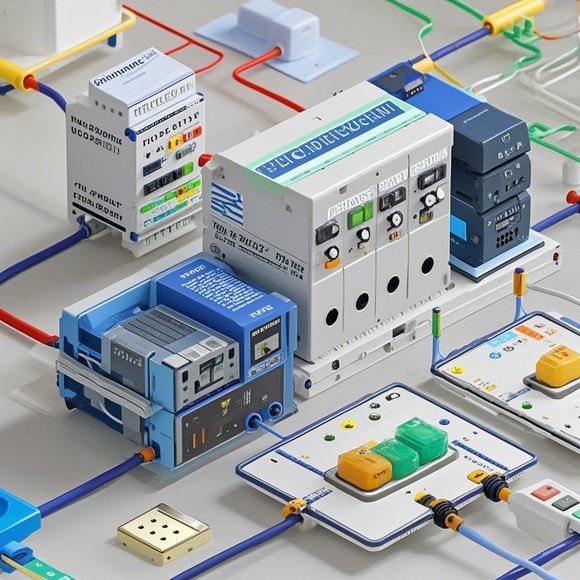PLC (Programmable Logic Controller) System Overview: A Journey Through the Principles
PLC, or Programmable Logic Controller, is a device that can be programmatically controlled and configured. It's used for automation in industrial environments to control the flow of production processes. The main principle of a PLC is based on logic programming. This means that the system uses algorithms to process inputs from various sensors and devices and outputs results based on those inputs. The PLC takes this information and translates it into commands that are sent to the hardware that controls the machinery or other systems. This kind of automation allows for greater efficiency and accuracy in industrial settings, as well as reducing the risk of human error. The flexibility of the PLC system also means that it can be adapted to different types of applications, making it one of the most popular pieces of automation equipment today.
In today's ever-evolving global marketplace, understanding the principles behind Programmable Logic Controller (PLC) systems is crucial for effective trade operations. A PLC system is a sophisticated digital computer that interfaces directly with industrial process control devices, enabling them to communicate and perform complex tasks autonomously. This system is often seen as the backbone of modern manufacturing, providing critical functions like data processing, monitoring, and controlling various aspects of industrial production processes. Let's delve into the world of PLC systems, exploring their components, functionalities, and how they contribute to the smooth operation of industrial machinery.

To begin with, a basic understanding of PLC systems is essential. These intelligent controllers are designed to handle high volumes of data, process it quickly, and execute commands efficiently. At their core, these systems consist of several key components, including:
1、Input Modules: These modules capture raw data from sensors, actuators, switches, and other sources, transforming it into a format that can be processed by the PLC. The input modules are crucial in ensuring accurate and reliable data is available for analysis and decision-making.
2、Output Modules: These modules are responsible for translating the information processed by the PLC into actual actions, such as controlling motors or actuators to alter system parameters. The output modules play a critical role in ensuring the desired outcomes are achieved in the industrial environment.
3、Process Control Logic: This component is responsible for interpreting the data received from the input modules and making decisions based on predefined rules or algorithms. The logic determines how the system reacts to changes, adjusting parameters accordingly to maintain stability and efficiency.
4、Communication Interfaces: These interfaces enable communication between different PLC systems, whether they belong to the same manufacturer or different brands. They facilitate the exchange of data and commands between the various components within a PLC network, ensuring seamless coordination and synchronization across the entire system.
The functionality of PLC systems extends far beyond mere data processing and control. They offer a wealth of capabilities that make it easier to manage complex industrial processes, optimize performance, and enhance overall efficiency. Some of the key features include:
1、Automation: PLC systems enable the automation of industrial processes, freeing up human operators from repetitive tasks, allowing them to focus on higher-value activities.
2、Real-Time Data Processing: Utilizing advanced algorithms and hardware, PLC systems process vast amounts of data in real time, enabling quick responses to changing conditions.

3、Flexibility: PLC systems can easily adapt to changing environments or new requirements without requiring costly modifications or upgrades.
4、Security and Reliability: By employing robust security measures and redundancy protocols, PLC systems minimize the risk of data loss or unintended outages.
5、Interconnectivity: PLC systems can be interconnected with each other and with other types of equipment, creating complex and efficient workflows that can span entire factories.
6、Customization: With the help of modular design and user-friendly software, PLC systems can be tailored to meet specific needs, whether for small-scale projects or large-scale industrial operations.
In addition to the above features, PLC systems also offer numerous advantages for businesses looking to scale up or diversify their industrial operations. For example:
1、Cost-Efficiency: Over time, investing in PLC systems can significantly reduce operational costs by streamlining processes and reducing energy usage.
2、Maintaining Inventory: Advanced inventory management capabilities offered by PLC systems can ensure that products remain in stock only when needed, minimizing waste and maximizing profits.
3、Adapting to Market Changes: With PLC systems, companies can more easily respond to market fluctuations by adjusting production schedules and pricing strategies.

4、Enhancing Product Quality: By closely monitoring production processes using PLC systems, businesses can identify areas for improvement and implement necessary adjustments to enhance product quality and customer satisfaction.
5、Improving Safety Standards: PLC systems provide an extra layer of safety controls, reducing the risk of accidents and incidents in hazardous environments.
As we move forward into the digital age, PLC systems continue to evolve at breakneck speed, incorporating cutting-edge technologies and innovative designs that push the boundaries of what's possible in industrial automation. From the latest developments in machine learning and big data to the integration of artificial intelligence and Internet of Things (IoT) technologies, PLC systems are set to become even more powerful and capable than ever before.
In conclusion, PLC systems represent a vital component of modern industry, offering unparalleled flexibility and efficiency in handling complex industrial processes. By understanding the fundamental components and functionalities of PLC systems, businesses can leverage these advanced technologies to optimize their operations, drive cost savings, and improve product quality, ultimately setting themselves up for success in an increasingly competitive market. As we look towards the future, let us embrace the possibilities presented by PLC systems and strive to stay ahead of the curve in our quest for excellence in industrial automation.
Content expansion reading:
Articles related to the knowledge points of this article:
PLC Controller Selection Guide for Foreign Trade Operations
PLC Programming for Automation Control in the Manufacturing Industry
PLC (Programmable Logic Controller) Control System Basics
Connecting a PLC Controller to Your Computer